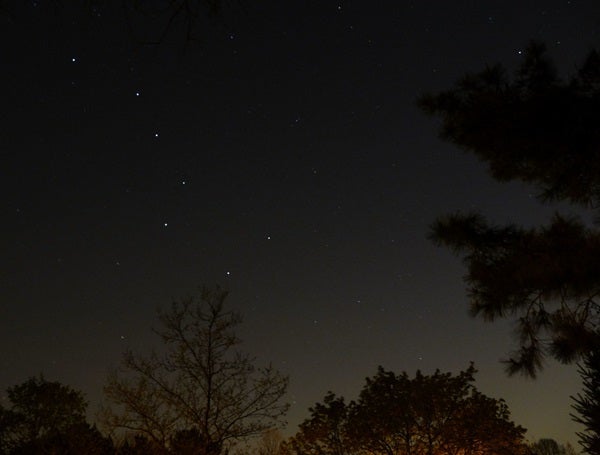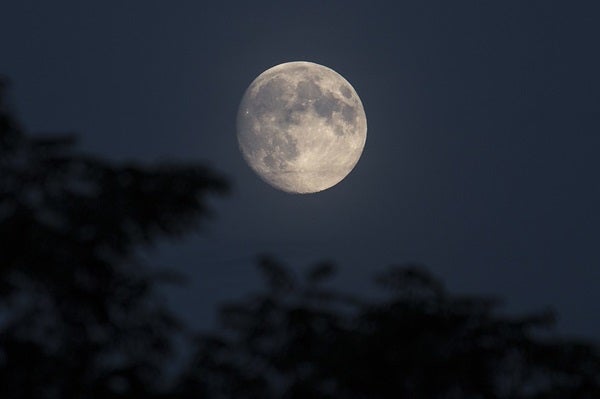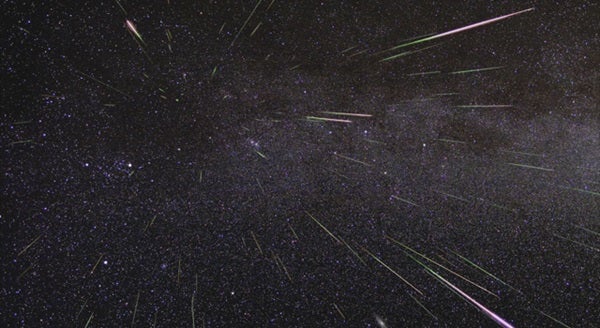Friday, August 4
The Big Dipper’s familiar shape appears halfway up the northwestern sky as darkness falls. One of the summer sky’s finest binocular double stars marks the bend of the Dipper’s handle. Mizar shines at 2nd magnitude, some six times brighter than its 4th-magnitude companion, Alcor. Even though these two are not physically related, they make a fine sight through binoculars. (People with good eyesight often can split the pair without optical aid.) A small telescope reveals Mizar itself as double — and these components do orbit each other.
Saturday, August 5
Distant Neptune reaches opposition and peak visibility in just a month, but the view now is essentially the same. The ice giant planet rises around 9:30 p.m. local daylight time and climbs nearly halfway to the zenith in the southern sky by 3 a.m. The magnitude 7.8 planet lies in Aquarius, 2° east of 4th-magnitude Lambda (l) Aquarii. You’ll need binoculars to spy Neptune and a telescope to see its blue-gray disk, which spans 2.4″.
Sunday, August 6
Asteroid 89 Julia should be relatively easy to find through small telescopes south of the Great Square of Pegasus. Your signpost for finding this magnitude 9.6 space rock is a squashed box of four 5th-magnitude stars: 55, 57, 58, and 59 Pegasi. The box lies 6° south of magnitude 2.5 Markab (Alpha [a] Peg), the star that marks the Great Square’s southwestern corner. Tonight, Julia stands 1.5° south of 59 Peg. If you sketch the field and then return to the same area a night or two later, you should be able to detect the asteroid’s movement relative to the stellar background.
Monday, August 7
Full Moon arrives at 2:11 p.m. EDT. It rises in the eastern sky just as the Sun sets and reaches its peak in the south shortly after 1 a.m. local daylight time. The Moon lies in the northeastern corner of the constellation Capricornus the Sea Goat. More significantly, in most of the world outside the Americas, observers with clear skies will see a partial lunar eclipse as the Moon passes into Earth’s shadow. Luna’s southern edge enters our planet’s dark umbral shadow at 17h22m UT and exits at 19h19m UT. Greatest eclipse occurs at 18h20m UT, when 25 percent of the Moon’s diameter resides in our planet’s shadow.
Tuesday, August 8
Jupiter appears low in the west-southwest an hour after sunset this week. The brilliant planet shines at magnitude –1.8 and dominates the evening sky. It appears against the backdrop of Virgo, some 7° to the right of the Maiden’s brightest star, 1st-magnitude Spica. When viewed through a telescope, Jupiter’s disk spans 34″ and shows a wealth of atmospheric detail.
Wednesday, August 9
By the time morning twilight starts to paint the sky, brilliant Venus already dominates the scene. The planet rises shortly after 3 a.m. local daylight time and stands 20° high an hour before sunrise. It’s hard to mistake Venus for anything else — at magnitude –4.0, it shines far brighter than any other object in the morning sky with the exception of the Moon. Although the view with the naked eye or through binoculars is dazzling, you’ll need a telescope to see the planet’s 14″-diameter disk, which appears about three-quarters illuminated. Venus appears against the background stars of western Gemini the Twins.
Thursday, August 10
The variable star Algol in Perseus reaches minimum brightness at 2:47 a.m. EDT tomorrow morning (11:47 p.m. PDT this evening), when it shines at magnitude 3.4. If you live in western North America and start viewing around the time of least luminosity, you can see it brighten by more than a magnitude during the next five hours. This eclipsing binary star runs through a cycle from minimum to maximum and back every 2.87 days.
Friday, August 11
The Perseid meteor shower peaks during daylight hours tomorrow, so the best viewing conditions occur tonight. Unfortunately, Full Moon occurred just a few days ago, and its bright light will drown out fainter meteors and leave the brighter ones less impressive in the prime viewing hours after midnight. Instead of seeing up to 100 meteors per hour as you might in a good year, a typical observer may see only 20 to 25 per hour. Your best bet is to view in the early morning hours of the 12th, when the shower’s radiant climbs high in the northeast. Position yourself facing north with the Moon to your back.
Saturday, August 12
Assuming you watch the Perseid show this morning, don’t pack up when twilight starts to paint the sky. About 45 minutes before the Sun comes up, look for a bright object hovering just above the horizon in the east-southeast. This is the night sky’s brightest star, magnitude –1.5 Sirius in the constellation Canis Major. From mid-northern latitudes, the luminary climbs some 4° high a half-hour before sunrise and should stand out if you have a clear and unobstructed horizon. The return of Sirius to the predawn sky was an occasion for celebration in ancient Egypt. Around 3000 b.c., this so-called heliacal rising of Sirius heralded the coming flood of the Nile River, an event upon which agriculture — and all life in Egypt — depended.
Sunday, August 13
Spectacular Saturn lies due south and at its peak altitude about an hour after sunset. It shines at magnitude 0.3 against the backdrop of southern Ophiuchus, a constellation whose brightest star glows six times fainter than the ringed planet. When viewed through a telescope, Saturn’s globe measures 17″ across while its dramatic ring system spans 40″ and tilts 27° to our line of sight. Tonight also offers a nice opportunity to see the planet’s seven brightest moons. The toughest to spot normally are the two inner ones — Mimas and Enceladus — which never stray far from the rings’ glare. But tonight, Enceladus reaches greatest eastern elongation just two hours after Mimas comes to greatest western elongation. Tethys, Dione, Rhea, Titan, and Iapetus round our Saturn’s “magnificent seven” satellites on display.












